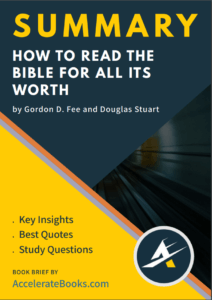How to Read the Bible for All Its Worth
by Gordon Fee and Douglas Stuart | Book Summary

Author: Gordon D. Fee and Douglas Stuart |
The Bible is composed of 66 individual books written by about 40 different authors over the course of 1500 years or so. These books span a variety of cultural contexts, intended audiences, and literary genres. All of this may sound rather intimidating at first, but the reality is, the Bible is meant to be read by everybody. If readers make the effort to think about the types of literature found in the Bible and the contexts in which these books were written, they will find themselves reading the Bible for all its worth. After all, the Bible is "better than gold, even much fine gold; This book, therefore, is a useful tool for anyone who wants to truly understand the inerrant, infallible, authoritative, and sufficient Word of God. |
After teaching at Regent College for 16 years, Gordon D. Fee now has the status of Professor Emeritus of New Testament. Previously he served as professor in other schools such as Wheaton College and Gordon-Conwell Theological Seminary. Dr. Fee has a passion for helping people understand the New Testament and has both written and spoken over the years to aid people in this endeavor.
Since 1971, Douglas Stuart has been a professor of Old Testament at Gordon-Conwell Theological Seminary. He is the author of numerous books including the New American Commentary on Exodus (2006). He has an expertise in ancient languages, including Biblical Hebrew. He and Dr. Fee currently have four editions of How to Read the Bible for All Its Worth (this book brief is over the third edition).
How to Read the Bible for All Its Worth
by Gordon Fee and Douglas Stuart
[ Book Summary ]

| Author | Gordon D. Fee and Douglas Stuart |
| Publisher | Zondervan |
| Date | November 9, 2003 (Third Edition) |
| Pages | 264 |
Overview:
The Bible is the most widely read book in the history of mankind. It's also the most misread book in human existence. How can a book so valuable, yet so often misunderstood, be read, comprehended, and treasured rightly? In step Gordon D. Fee and Douglas Stuart.
The Bible is composed of 66 individual books written by about 40 different authors over the course of 1500 years or so. These books span a variety of cultural contexts, intended audiences, and literary genres. All of this may sound rather intimidating at first, but the reality is, the Bible is meant to be read by everybody.
If readers make the effort to think about the types of literature found in the Bible and the contexts in which these books were written, they will find themselves reading the Bible for all its worth. After all, the Bible is "better than gold, even much fine gold;
sweeter also than honey and drippings of the honeycomb" (Psa. 19:10).
This book, therefore, is a useful tool for anyone who wants to truly understand the inerrant, infallible, authoritative, and sufficient Word of God.
After teaching at Regent College for 16 years, Gordon D. Fee now has the status of Professor Emeritus of New Testament. Previously he served as professor in other schools such as Wheaton College and Gordon-Conwell Theological Seminary. Dr. Fee has a passion for helping people understand the New Testament and has both written and spoken over the years to aid people in this endeavor.
Since 1971, Douglas Stuart has been a professor of Old Testament at Gordon-Conwell Theological Seminary. He is the author of numerous books including the New American Commentary on Exodus (2006). He has an expertise in ancient languages, including Biblical Hebrew. He and Dr. Fee currently have four editions of How to Read the Bible for All Its Worth (this book brief is over the third edition).


